- Home
- Gastronomy
- Yucatecan Gastronomy
Yucatecan Gastronomy
The Ultimate Guide to Yucatecan Cuisine! Discover the authentic Yucatecan cuisine and its most iconic dishes, delicious snacks, and regional specialties, from the true local experts’ POV!
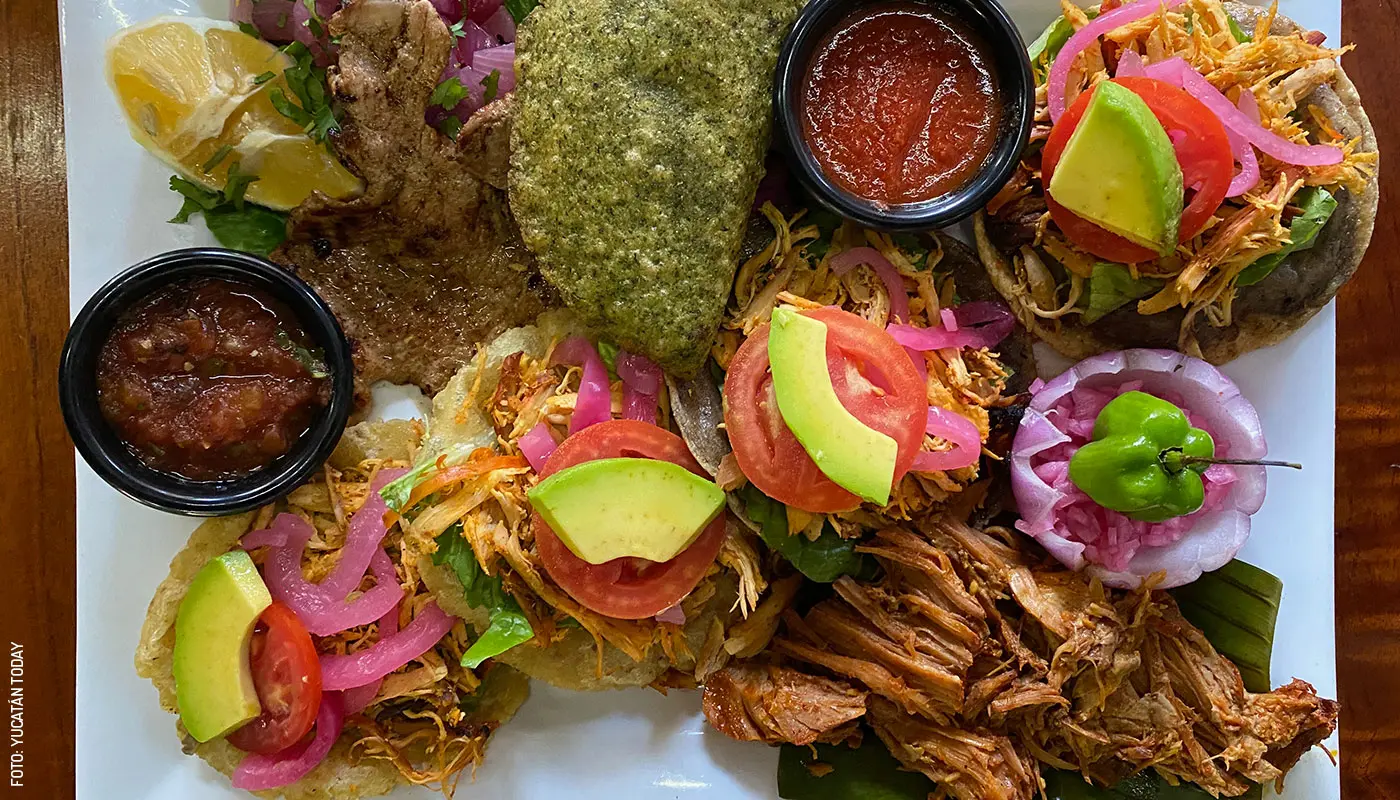
The Ultimate Guide to Yucatecan Cuisine
Yucatán is home to rich and traditional cuisine that mixes ingredients common to all of México (such as corn, tomato, and beans), with many products that are unique to the state (such as Habanero peppers, bitter orange, and the popular Achiote (annatto seed paste) that gives color and flavor to many meals.
As if that weren’t enough, Yucatán’s traditional dishes have further been enriched through the influence of what have historically been the state’s key historical counterparts, which include several Caribbean and European countries (Spain, of course, but later in history, others involved in the sisal fiber trade), as well as Lebanon, as Yucatán opened its doors to refugees fleeing the Ottoman Empire’s persecution of Christians beginning in 1892.
This rich historical exchange has given way to a very particular cuisine, quite differentiated from that of the rest of México and other nearby regions, both in the Caribbean and in Central América.
Nowadays, Yucatecan cuisine is internationally recognized due to its traditional cultural richness and its elaborate dishes, which usually take entire hours to prepare and which delight and surprise those who are expecting merely an extension of what they know as Mexican food.
Sopa de Lima
Sopa de lima (lime soup) is a humble broth (originally turkey, usually chicken) that’s then seasoned with the basic Yucatecan cuisine trifecta: onion, tomato, and chile dulce (a local variety of bell pepper or Capsicum annuum).
What gives sopa de lima its particular taste (and, of course, its name) is the Yucatecan lime. A citrus fruit very different from the limes and lemons you may know from elsewhere, Yucatecan limes are green and have a distinctive “bump,” in addition to its unique taste. Sopa de lima is made with its juice and slices, in addition to shredded meat and fried tortilla strips.
.jpg?width=800&height=400&name=Cocina-Yucateca-sopa-de-lima-by-Yucatan-Today%20(1).jpg)
Cochinita Pibil
Perhaps Yucatán’s best-known dish, cochinita pibil is made of pork seasoned with annatto paste, garlic, and bitter orange, wrapped in banana leaves and cooked underground; as a matter of fact, the word “pibil” alludes to the Maya name of the underground oven, píib.
Nowadays, cochinita can also be prepared either in a regular oven or a slow cooker; when made the traditional way, underground, it will usually be referred to as “cochinita enterrada.” Find it in regional restaurants and as street food, served in tacos and tortas (sandwiches), always with pickled red onion.
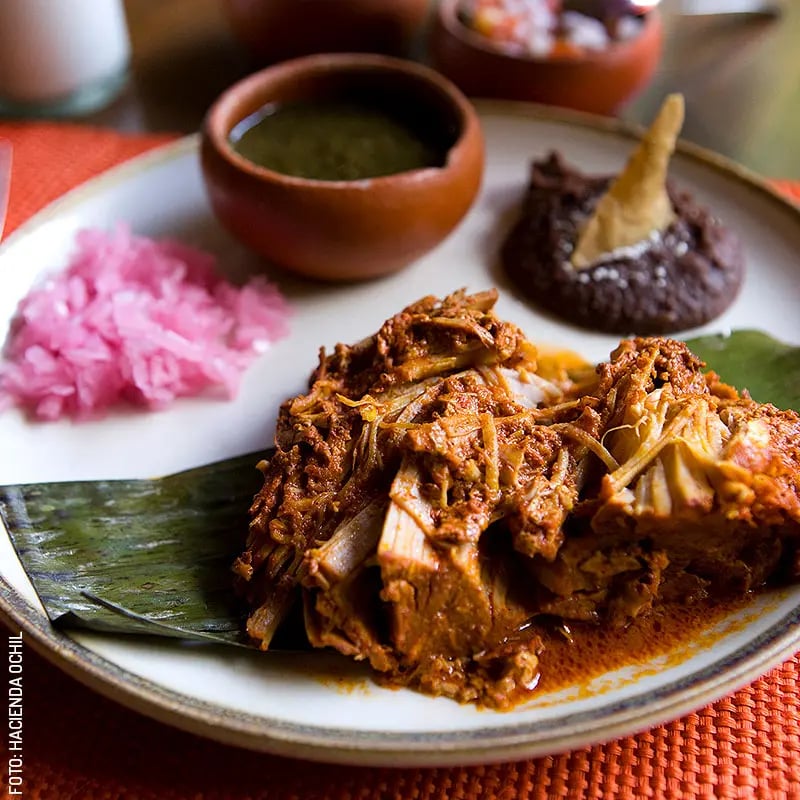

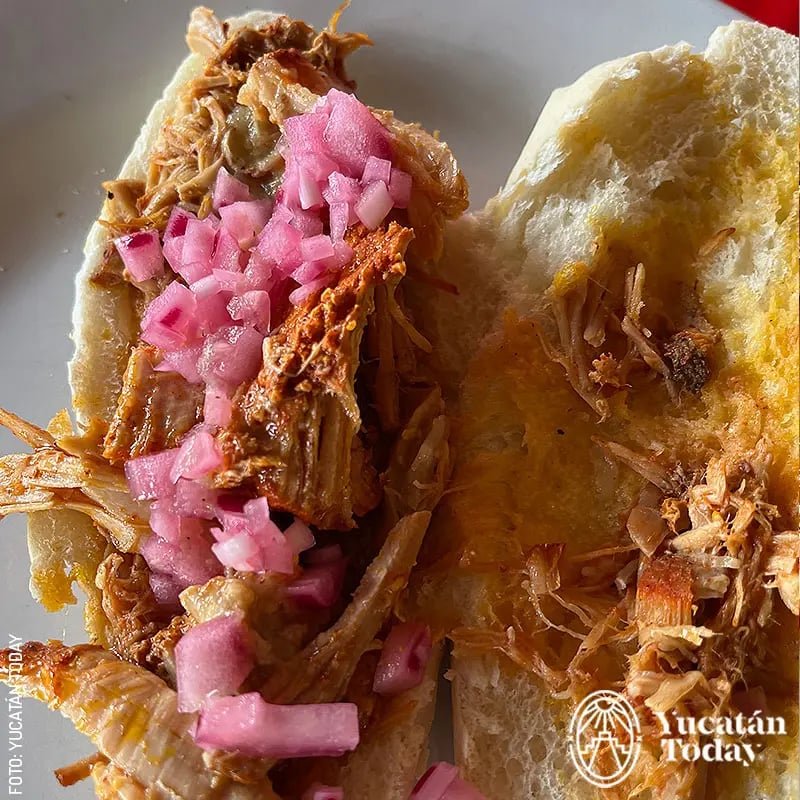
Panuchos and salbutes
After cochinita pibil, no Yucatecan dish is more widely known than the humble panucho and salbut. They consist of a fried, hand-made tortilla that is topped with either a slice of boiled egg or shredded turkey or chicken, plus pickled onions and vegetables like tomato, cucumber, avocado, etc. More recently, panuchos and sabutes are being topped with dishes like cochinita or relleno negro instead.
What’s the difference between a panucho and a salbut, you ask? The tortilla in panuchos is crunchy, and filled with refried beans, while the tortilla in salbutes should be soft and fluffy.
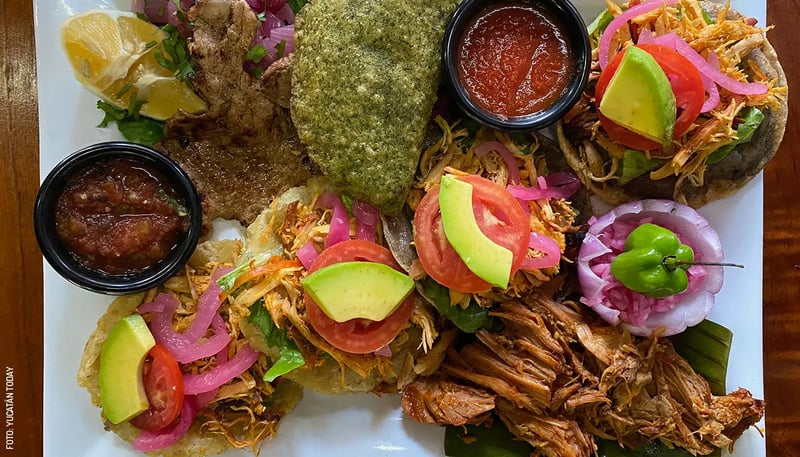
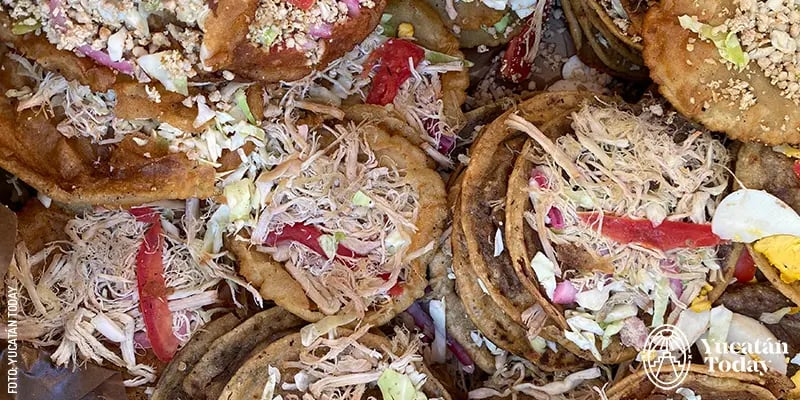
Pollo pibil
A poultry alternative to Cochinita Pibil, but, unlike Cochinita, it is usually served with rice and beans in addition to the customary tortillas.

Poc Chuc
This roasted pork filet is served with bitter orange, red onion, tomato sauce, avocado, and Habanero on the side. It’s usually accompanied by frijol colado, a blended bean soup. The Magical Town of Maní is especially famous for its poc chuc, which may be why it’s a staple at many of its restaurants. Poc chuc is also a great choice if you’re looking for a somewhat lighter option while eating out in Yucatán.
Also famous for Poc-Chuc, the Tías at Kaua.

Queso relleno
Prepared with a hollowed-out Edam cheese, which is then filled with ground pork, almonds, raisins, capers, and local spices. It’s covered in a white sauce known as K’ool made with flour, lard, and chicken broth; finally, it’s topped with tomato sauce. Are you feeling brave? Try making it at home by following our recipe.

Relleno negro
This traditional pork and turkey (or chicken) dish is seasoned with recado negro, a spice blend made from charred chiles and herbs; relleno negro is uniquely spicy and tasty, but also a deep, thick shade of black. It is served with but (pronounced boot), a sort of pork meatball filled with hard-boiled eggs. Your dish should include a slice of but and either turkey or chicken, in a “soup” of black broth. Relleno negro used to be served at traditional weddings and it’s one of the oldest recipes in our regional cuisine.
Recado negro, by the way, is especially time-consuming to make from scratch. Most Yucatecos buy it either pre-packed from the supermarket or more artisanally made at local markets. If you’re not into spicy food beware: even “non-spicy” recado negro can be quite hot

Marquesitas
Marquesitas were created by sorbet-maker Helados Polito to make up for wintertime losses. They are, basically, an artisanally-made sugar cone (except, you know, tube-shaped) filled with shredded cheese instead of ice cream. Nowadays, in addition to the Edam cheese that originated them, they’re prepared with fillings such as Nutella, dulce de leche, condensed milk, fruit jam, and many others.
Marquesitas are, undoubtedly, Yucatán’s most popular sweet street snack. Find them at most parks, outside churches, and scattered all along Paseo de Montejo.

The following dishes are less widely known, and not as easily available in regional restaurants; however, they’re also staples of every Yucateco’s diet.
Lechón al Horno
Based on the Spanish dish of the same name (but also known as cochinillo asado), lechón al horno is roasted with bay leaves. While you can find it at some restaurants, Yucatecos usually have it for breakfast at street stands, served in tacos and tortas (sandwiches).
What makes lechón deliciously unique are small pieces of crunchy, tasty cáscara (rind). Yucatecan lechón should be so tender it falls apart, and is served with a bitter orange, onion, and tomato “dressing” on top.
Escabeche oriental
Charcoal-grilled turkey or chicken, seasoned with onion, pepper, sour orange, and local herbs. It owes its name both to its place of origin (Eastern Yucatán) and the eastern spices (such as cinnamon) it incorporates. The meat can be either in pieces or shredded, served in the broth with plenty of onion and Xcatic pepper.

Frijol con Puerco
A black bean broth with pieces of cooked pork. It is served with rice (cooked in bean broth) and topped with finely chopped radish, cilantro, onion, and tomato sauce. It’s Yucatán’s official Monday meal!

Relleno blanco
Turkey served with a ground pork “meatball” that is seasoned with capers, oregano, raisins, and olives. It’s then bathed in K’ool and tomato sauces.
Huevo con Chaya (eggs with Chaya)
As the name suggests, it consists of scrambled eggs with the traditional Chaya leaves (Cnidoscolus chayamansa or tree spinach) that grow so abundantly in the region. As its English name suggests, the taste of Chaya will remind you of spinach, but different. Huevo con Chaya is traditionally a homemade dish.
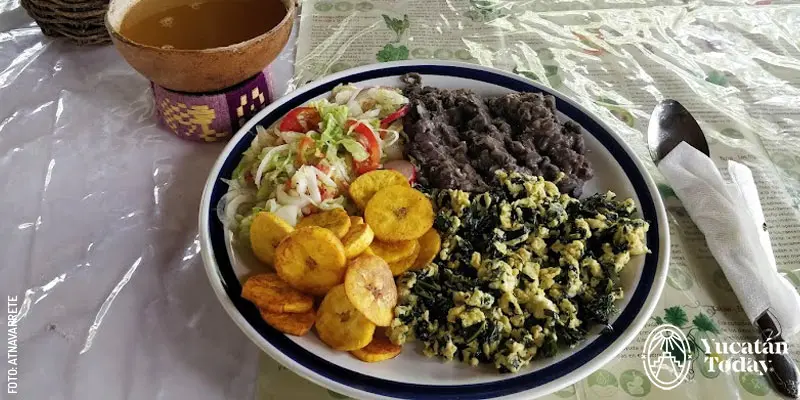
Huevos Motuleños
This dish consists of fried eggs served on top of a fried tortilla with beans, then covered with tomato sauce, chopped ham, cheese, and peas. It is usually adorned with fried plantains. It’s a very traditional breakfast dish that also makes for a hearty lunch. And while Huevos Motuleños were created in the Magical Village of Motul, the man behind the recipe is said to be Don Jorge Siqueff, founder of Siqueff restaurant.

Tacos y Tortas de Cochinita Pibil or Lechón al Horno. See below.
One of the breakfast options that most Yucatecos can’t live without (especially on weekends) can be found at small loncherías and food stands both in markets and streets. We’re talking about tacos and tortas (sandwiches) whose most popular ingredients (besides either the corn tortilla or a half loaf of “pan francés”) are cochinita pibil, lechón al horno, asado (grilled pork, either achiote red or plain), or relleno negro.
For Yucatecos, botanas (snacks) are a way of life: a moment to unwind and share good conversation and good food with family or friends, whether at home or at a restaurant or botanero. Here are the most traditional Yucatecan botanas.
Codzitos
Crunchy corn tortilla tacos that are usually filled with...absolutely nothing. They’re just the crunchy taco shell, covered with tomato sauce and sprinkled with Sopero cheese (similar to Cotija), yet surprisingly tasty.
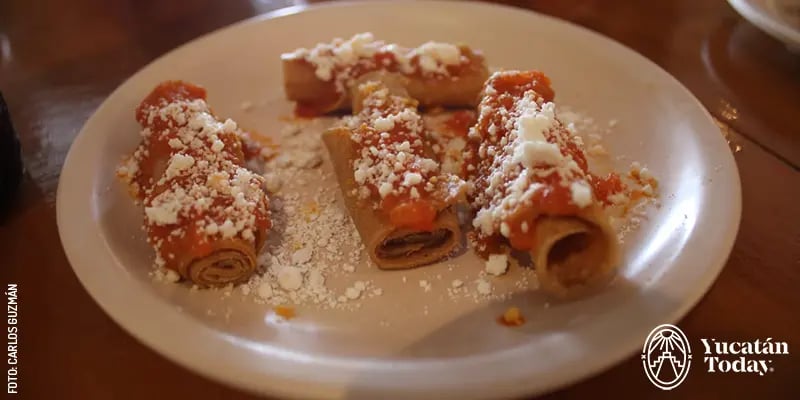
Pickled potato salad
This tangy dish may sometimes be made with sliced sausages, but you’ll find that the most abundant ingredients are potatoes, onions, and sometimes cilantro; be wary when trying it, since some places throw in slices of Habanero. It’s a good idea to ask as soon as it’s served.
Kibis
Kibis are a tropicalized version of Lebanese kibbeh; you’ll find them in a variety of shapes, price ranges, and presentations, but usually served with pickled onions, cabbage, or both. In cantinas, they are usually served as small patties, about five centimeters in diameter; as street food, you’ll see them transported in containers that resemble fish tanks, oval-shaped like an American football. These are hollow inside; the “Kibero (Kibi vendor)” fills them with pickled onions and cabbage when handing them to you unless you ask otherwise. Lebanese restaurants serve more authentically Middle-Eastern versions.

Chayitas
Presentations vary, but these are usually fried masa with chopped Chaya, sometimes served with tomato sauce, but sometimes with Xnipek (chopped tomato, onion, cilantro, bitter orange, and, optionally, Habanero).
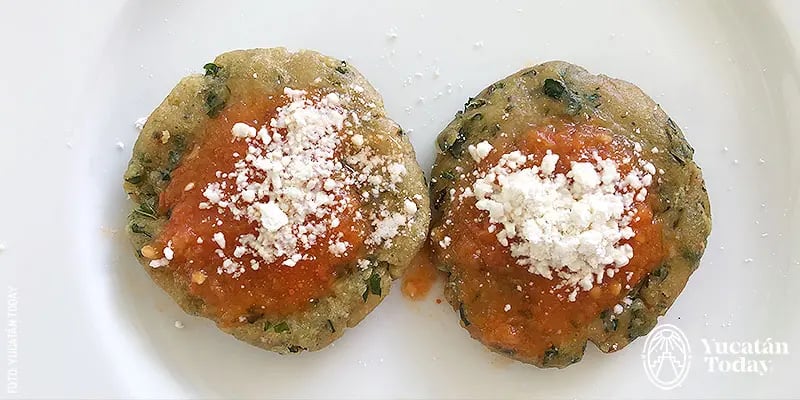
Polcanes
Though some presentations might look similar to what you might know as “Gorditas,” authentic Polcanes are distinguished by their particular shape, similar to a snake’s head (Pool K’aan, in Maya). Fillings may vary, but the traditional one is Tooksel, which is a vegan-friendly dish made with iibes (lima beans, Phaseolus lunatus) and ground Pepita (pumpkin seed).

Sikil P’aak
A traditional dip made with toasted pumpkin seed, cilantro, and roasted tomato. It’s another great vegan snack, usually served alongside tortilla chips.

Xe’ek’
This refreshing salad is made with jicama and citrus, usually oranges and mandarins. Some people add ground chili—either Maax (Capsicum annuum var. glabriusculum) or Habanero—, and some also include cilantro. However you try it, it’s a very traditional snack, especially in the fall, which is the season for both jicama and citrus. “Xe’ek’” is also the word we use in Yucatán to describe something messy: “Your room is a Xe’ek’!”
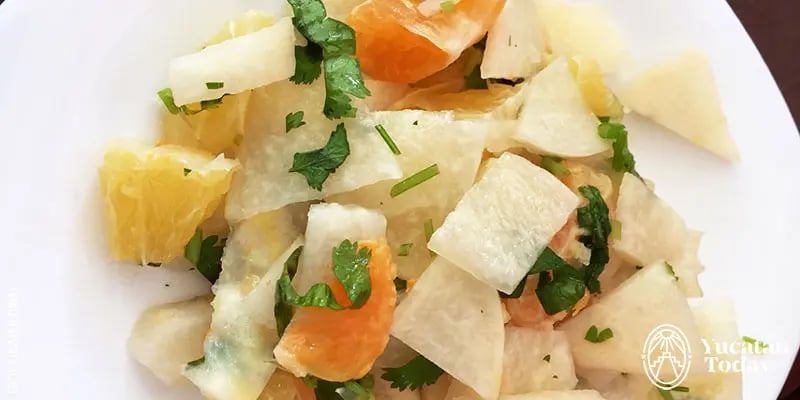
Papadzules
These tacos are filled with chopped hard-boiled egg and covered in two sauces: one is made with toasted pumpkin seed and the other is a tomato sauce. Ideal for vegetarians and omnivores alike.
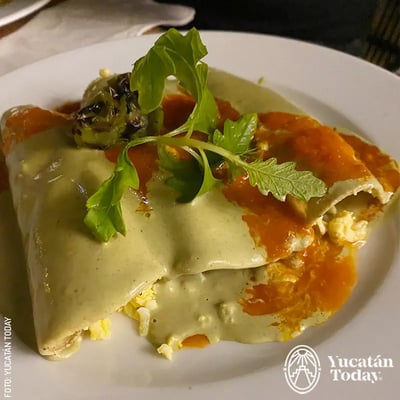
Mondongo Kabic
This is a very thick broth made from beef stomach and hooves. These are marinated in Achiote, garlic, and lots of bitter orange juice. It is served with whole Habanero peppers, onion, chives, and cilantro. You can usually find it at markets on the weekends.
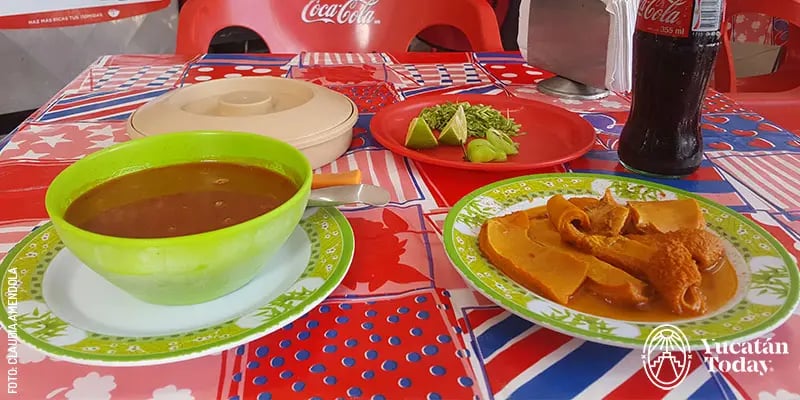
Mondongo a la Andaluza
Similar to Kabic, a beef stomach and hoove broth, but with the addition of traditionally Spanish ingredients, such as sausage, bacon, ham, paprika, and chickpeas.
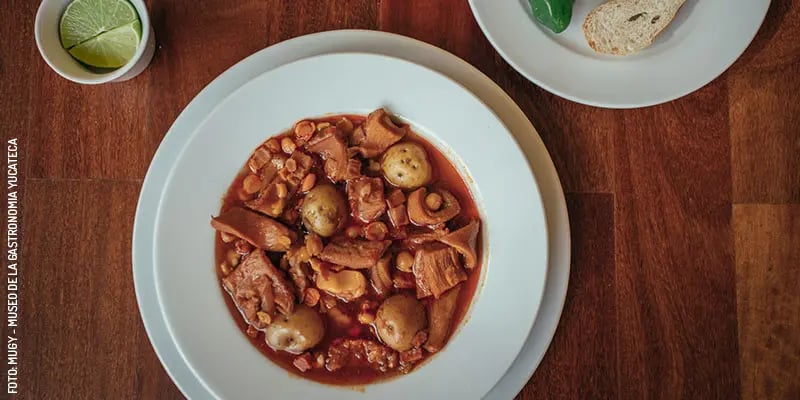
Puchero
The best known version incorporates three types of meat: chicken, pork, and beef, alongside noodles and many vegetables like squash, chayote, and carrots. It’s served with Salpicón (a different version of Pico de Gallo made with radish, cilantro, and bitter orange) for the broth, plus a dish so everyone can “Puch” (mash) their vegetables and meat.
Chocolomo
Despite what its name might suggest, there’s nothing chocolatey about this dish; it comes from the Maya word Chokoj, which means hot. It’s a beef loin broth prepared with offal, garlic, and onion, served with a garnish of radish, cilantro, bitter orange, and optionally, Habanero peppers.
Lomitos de Valladolid
Diced pork loin prepared with a slightly spicy tomato sauce. It’s served with chopped hard-boiled eggs.

Longaniza de Valladolid
Pork sausage seasoned with garlic, pepper, and vinegar. As a standalone dish, it’s served with pickled onion, bitter orange, refried beans, tomato sauce, and handmade tortillas, but it can also be incorporated into other dishes as an ingredient. Planning to visit Valladolid? Here’s your guide to this Magical Village.

Carne Ahumada de Temozón
Wood-smoked pork meat; when served in tacos, you should get sides of bitter orange, avocado, red onion, tomato sauce, and beans. Find out more about Temozón, its sights, and specialties.

Kots’ob de Espita
Similar to a rolled-up tamal, Kots’obes are made from white beans, ground chili, pumpkin seed, masa, and other local ingredients wrapped in Hoja Santa (Mexican pepperleaf, or Piper auritum). In Espita you can find it grilled, fried, or steamed. Interested in visiting the Magical Village of Espita? Click here to find out what awaits.
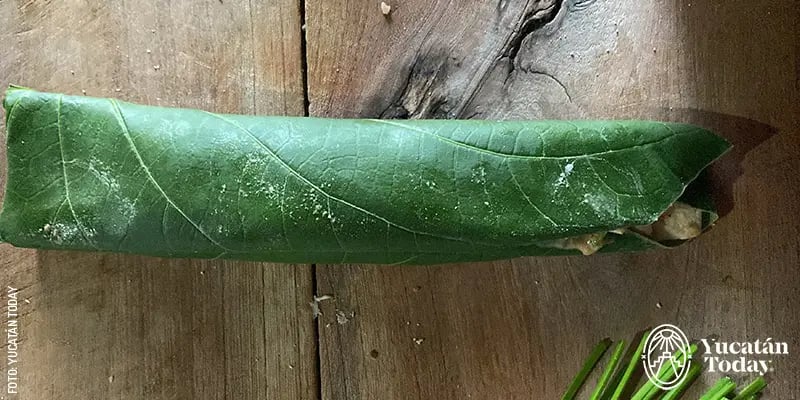
Mukbilpollo
Many describe this as a giant and crunchy tamal. It has a crispy, golden dough and a chicken, turkey, or pork filling (sometimes all of the above). It is baked wrapped in banana leaves, usually in a Píib underground oven. Mukbilpollo, known in Mérida as Pib, is traditionally served during November for the Janal Pixan festivities. Find out more about Mukbilpollo, its preparation, and its deeper meaning through our article Mukbilpollo, a Melancholy Ritual.

For many Yucatecos, a few traditional dishes can’t be paired with anything other than a soda (or beer); however, there’s nothing like enjoying them with a very refreshing traditional drink.

Horchata
Horchata is believed to have originated in North Africa, from where it would have been introduced into Spain, and then, of course, brought to México. Widely popular in México and Latin América, it is prepared with rice and cinnamon.
Chaya (aka tree spinach)
Chaya is plant native to Yucatán whose leaves are very nutritious, with a taste that might remind you of spinach. At traditional restaurants, you might find beverages made with chaya leaves blended with either pineapple (chaya con piña) or lime (chaya con limón).
Agua de lima
The same citrus fruit used for sopa de lima is also the base of a delicious, refreshing beverage. Agua de lima (or just “lima”) is similar to lemonade (and prepared like one, mixing lima juice with water and sugar), but with the unique flavor of this citrus variety.
Xtabentun (shh-tab-en-TOON)
This alcoholic beverage is a spirit made with anise, honey, and rum. On its own it is consumed as a digestif, but it’s also featured in local mixology and in specialty coffees.
Artículos relacionados
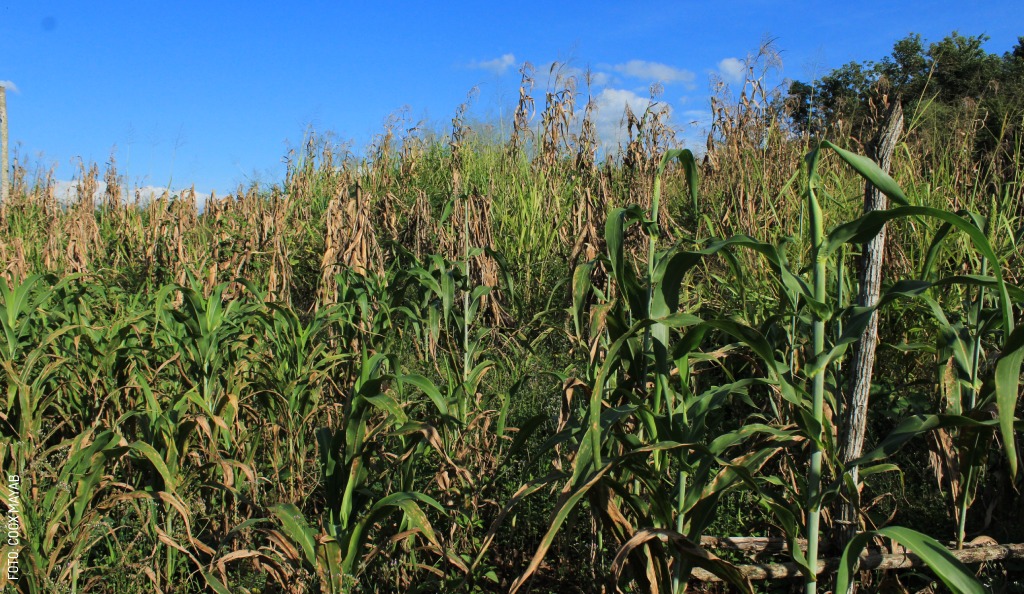
Cabañuelas: Predicciones del Clima para 2026

Conociendo Yucatán: Una escapada de dos días por el Sur de Yucatán

12 propósitos de Año Nuevo al estilo yucateco
Related Posts
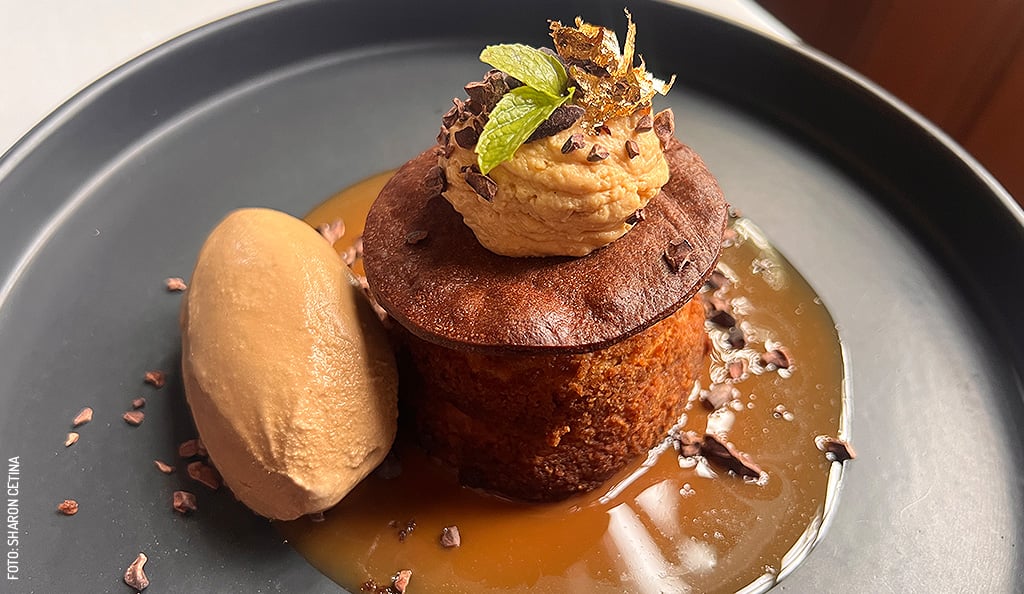
Always Room for Dessert: 4 Outstanding Restaurants in Mérida

The New NUUP Location: Flavor to Fuel Your Journey Through Mérida








